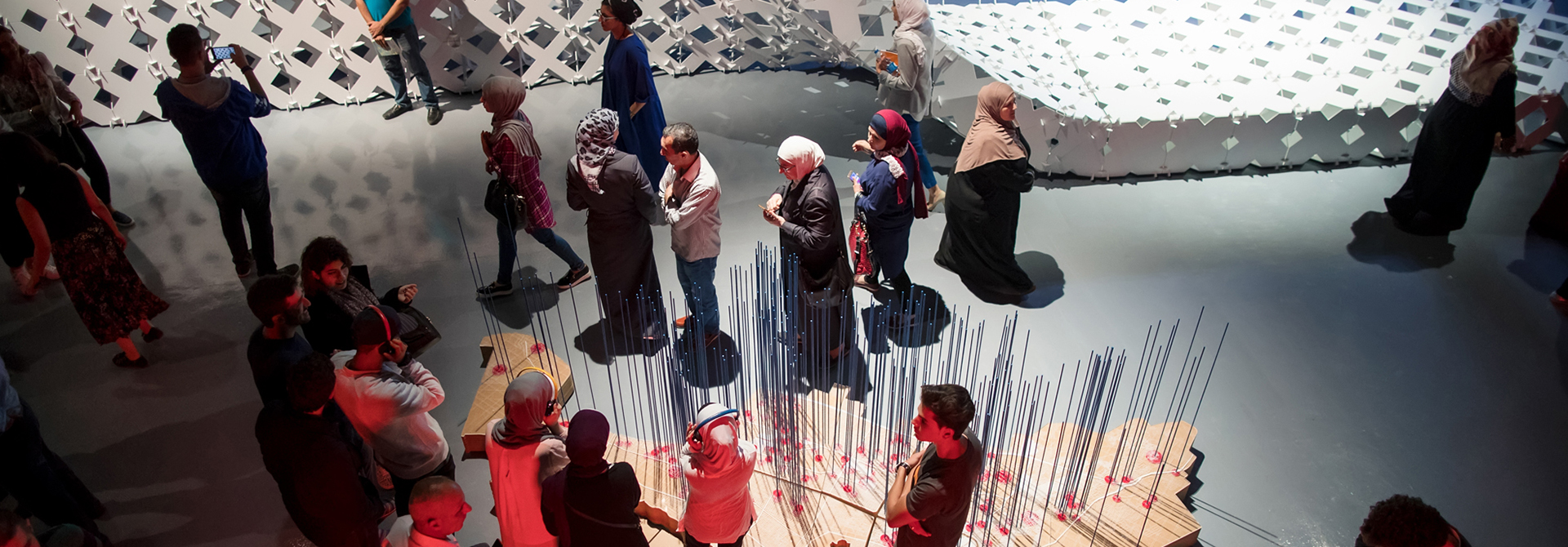

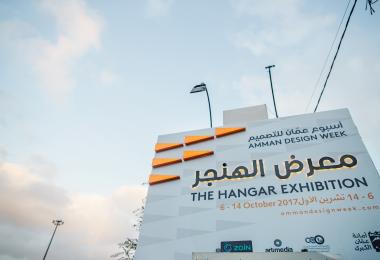
The Hangar Exhibition
The 2017 Hangar Exhibition, curated by Ahmad Humeid, presents work by local and regional designers in response to the theme of ‘movement’, whether physical, intellectual, cultural, or social.
© Amman Design Week 2017
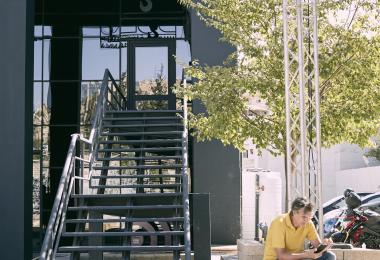
The Hangar Exhibition
The 2017 Hangar Exhibition, curated by Ahmad Humeid, presents work by local and regional designers in response to the theme of ‘movement’, whether physical, intellectual, cultural, or social.
© Amman Design Week 2017
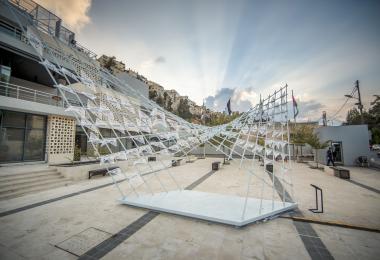
A path of synergy (2017)
Rawan Kakish, Hamad Al Sultan
This installation integrates computational processes and digital techniques for data collection of human movements, which are reflected through the change of light and motion intensities of butterfly-like components.
Following research on butterfly insects, particularly analyzing the movement of their wings and the different flying behaviors and patterns, the piece was composed of two main parts: the body, and the wings. The former houses the electronic parts, including sensors, servo-motors, arduino microcontroller and LED light. The latter is connected to the body, and is activated by the servomotors through the collected data of distances from the sensors. The activation takes the form of changing and controlling the intensity of both the LED light and the rotation of the wings, which are both performed simultaneously. This component is aggregated on a hyperbolic paraboloid structure and distributed in a distinctive pattern.
© Amman Design Week 2017
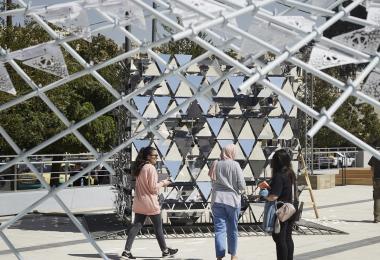
A path of synergy (2017)
Rawan Kakish, Hamad Al Sultan
This installation integrates computational processes and digital techniques for data collection of human movements, which are reflected through the change of light and motion intensities of butterfly-like components.
Following research on butterfly insects, particularly analyzing the movement of their wings and the different flying behaviors and patterns, the piece was composed of two main parts: the body, and the wings. The former houses the electronic parts, including sensors, servo-motors, arduino microcontroller and LED light. The latter is connected to the body, and is activated by the servomotors through the collected data of distances from the sensors. The activation takes the form of changing and controlling the intensity of both the LED light and the rotation of the wings, which are both performed simultaneously. This component is aggregated on a hyperbolic paraboloid structure and distributed in a distinctive pattern.
© Amman Design Week 2017
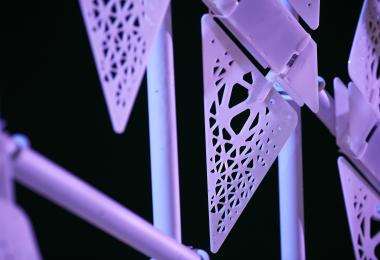
A path of synergy (2017)
Rawan Kakish, Hamad Al Sultan
This installation integrates computational processes and digital techniques for data collection of human movements, which are reflected through the change of light and motion intensities of butterfly-like components.
Following research on butterfly insects, particularly analyzing the movement of their wings and the different flying behaviors and patterns, the piece was composed of two main parts: the body, and the wings. The former houses the electronic parts, including sensors, servo-motors, arduino microcontroller and LED light. The latter is connected to the body, and is activated by the servomotors through the collected data of distances from the sensors. The activation takes the form of changing and controlling the intensity of both the LED light and the rotation of the wings, which are both performed simultaneously. This component is aggregated on a hyperbolic paraboloid structure and distributed in a distinctive pattern.
© Amman Design Week 2017
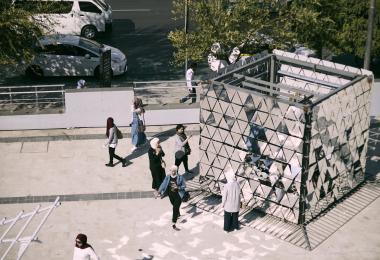
X3 (2017)
Uraiqat Architects
'X3' initiates a conversation between the image of the user in its reflective surfaces and the backdrop of the urban buildings and surrounding environment. This conversation is a dialogue between the self and the other that is born from the monologue between the I and the self, the object and image, the vision and perception. It invites a questioning of relationships and connections, and shakes the ground underneath the given notions of separations and disconnections. It blurs boundaries between spatial fields and erases borders of the tangible.
When faced with dancing fragments of self-image and transforming colors of skies and buildings, the user is challenged to play, move and perform the dance of questioning. A choreography that results in the deconstruction and reconstruction of identities, and a de-territorialization and reterritorialization of individual and collective space. ‘X3’ is a solid gone fluid, a structure gone rogue, a similarity gone different, a singularity gone multiple. It is an object disseminated through space, and society disseminated through movement.
© Amman Design Week 2017
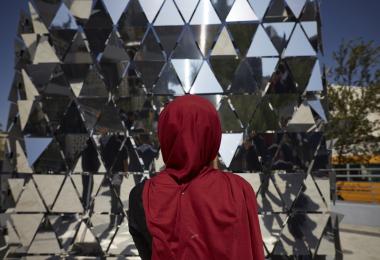
X3 (2017)
Uraiqat Architects
'X3' initiates a conversation between the image of the user in its reflective surfaces and the backdrop of the urban buildings and surrounding environment. This conversation is a dialogue between the self and the other that is born from the monologue between the I and the self, the object and image, the vision and perception. It invites a questioning of relationships and connections, and shakes the ground underneath the given notions of separations and disconnections. It blurs boundaries between spatial fields and erases borders of the tangible.
When faced with dancing fragments of self-image and transforming colors of skies and buildings, the user is challenged to play, move and perform the dance of questioning. A choreography that results in the deconstruction and reconstruction of identities, and a de-territorialization and reterritorialization of individual and collective space. ‘X3’ is a solid gone fluid, a structure gone rogue, a similarity gone different, a singularity gone multiple. It is an object disseminated through space, and society disseminated through movement.
© Amman Design Week 2017
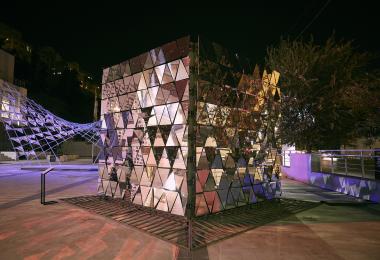
X3 (2017)
Uraiqat Architects
'X3' initiates a conversation between the image of the user in its reflective surfaces and the backdrop of the urban buildings and surrounding environment. This conversation is a dialogue between the self and the other that is born from the monologue between the I and the self, the object and image, the vision and perception. It invites a questioning of relationships and connections, and shakes the ground underneath the given notions of separations and disconnections. It blurs boundaries between spatial fields and erases borders of the tangible.
When faced with dancing fragments of self-image and transforming colors of skies and buildings, the user is challenged to play, move and perform the dance of questioning. A choreography that results in the deconstruction and reconstruction of identities, and a de-territorialization and reterritorialization of individual and collective space. ‘X3’ is a solid gone fluid, a structure gone rogue, a similarity gone different, a singularity gone multiple. It is an object disseminated through space, and society disseminated through movement.
© Amman Design Week 2017
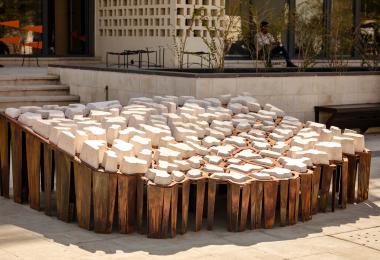
ARID (2017)
MEAN - Middle East Architecture Network - Hashem Joucka, Michael Pryor, Riyad Joucka
'ARID’ is a stone installation, symbolic of a post-drought landscape in Jordan that is the result of the imminent problem of water scarcity. The novelty of the project's materiality will be an outcome of processing natural and rough materials with imperfections, juxtaposed with the precision of digital manufacturing. Natural stone is milled using CNC manufacturing of computer-generated geometries.
© Amman Design Week 2017
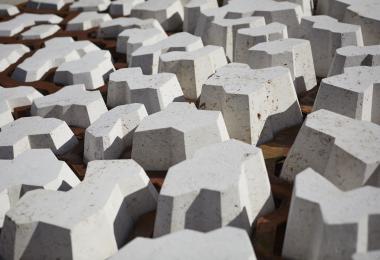
ARID (2017)
MEAN - Middle East Architecture Network - Hashem Joucka, Michael Pryor, Riyad Joucka
'ARID’ is a stone installation, symbolic of a post-drought landscape in Jordan that is the result of the imminent problem of water scarcity. The novelty of the project's materiality will be an outcome of processing natural and rough materials with imperfections, juxtaposed with the precision of digital manufacturing. Natural stone is milled using CNC manufacturing of computer-generated geometries.
© Amman Design Week 2017
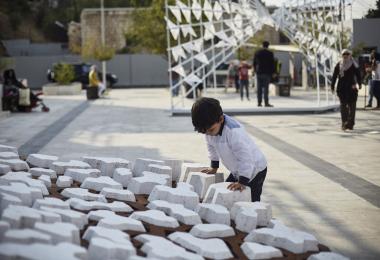
ARID (2017)
MEAN - Middle East Architecture Network - Hashem Joucka, Michael Pryor, Riyad Joucka
'ARID’ is a stone installation, symbolic of a post-drought landscape in Jordan that is the result of the imminent problem of water scarcity. The novelty of the project's materiality will be an outcome of processing natural and rough materials with imperfections, juxtaposed with the precision of digital manufacturing. Natural stone is milled using CNC manufacturing of computer-generated geometries.
© Amman Design Week 2017
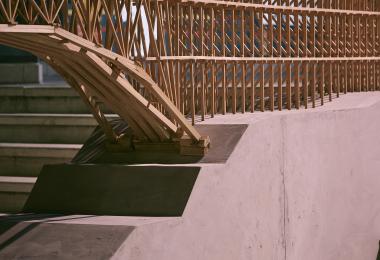
Masonry Bridge (2017)
Ammar Khammash
This model shows the scaffolding designed for a masonry bridge with one of the longest spans of its kind (46 m) at a dramatic location in Wadi Al-Hidan. The importance of scaffolding or shuttering is that it behaves like a 'trace fossil' of an animal, but unlike in the the world of fossils, here, the animal will last, and the trace fossil will disappear.
© Amman Design Week 2017
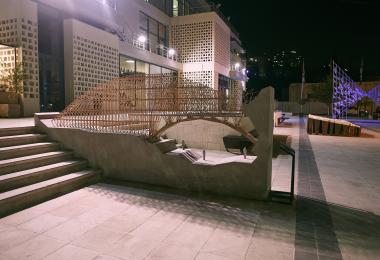
Masonry Bridge (2017)
Ammar Khammash
This model shows the scaffolding designed for a masonry bridge with one of the longest spans of its kind (46 m) at a dramatic location in Wadi Al-Hidan. The importance of scaffolding or shuttering is that it behaves like a 'trace fossil' of an animal, but unlike in the the world of fossils, here, the animal will last, and the trace fossil will disappear.
© Amman Design Week 2017
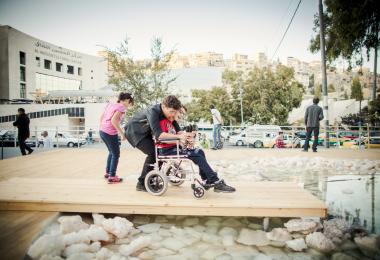
Salt Pond (2017)
Amal Ayoub
In an exploration of the current condition of the Dead Sea, this landscape installation creates a contradictory dialogue between the beautiful aesthetic of natural salt formations and the underlying currents of alarm at the new ‘dry’ Dead Sea. It highlights the rareness and beauty of this body of water, the fragile nature of this rare local treasure, and concern for the future of the site. It promotes the need for balance between sustainable industry that benefits the local community, and efforts to revitalize the body of water through design and conservation initiatives.
© Amman Design Week 2017
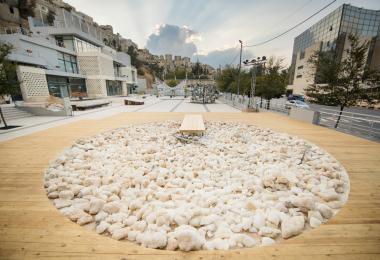
Salt Pond (2017)
Amal Ayoub
In an exploration of the current condition of the Dead Sea, this landscape installation creates a contradictory dialogue between the beautiful aesthetic of natural salt formations and the underlying currents of alarm at the new ‘dry’ Dead Sea. It highlights the rareness and beauty of this body of water, the fragile nature of this rare local treasure, and concern for the future of the site. It promotes the need for balance between sustainable industry that benefits the local community, and efforts to revitalize the body of water through design and conservation initiatives.
© Amman Design Week 2017
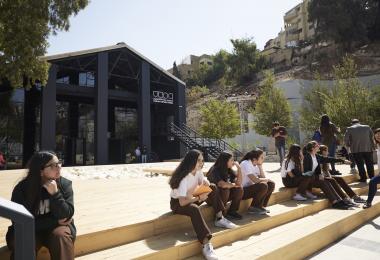
Salt Pond (2017)
Amal Ayoub
Students taking a school tour sit by the Salt Pond by Amal Ayoub.
© Amman Design Week 2017
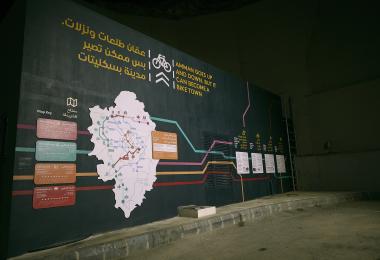
Amman Cycling Map (2017)
Ahmad Asem Al-Hiari, Yassin Al-Tubor
An imagined bike-map for the city of Amman.
© Amman Design Week 2017
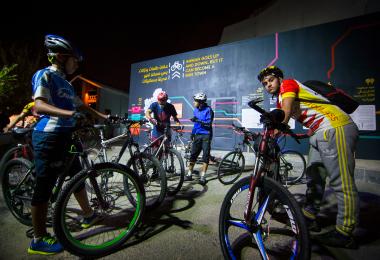
Amman Cycling Map (2017)
Ahmad Asem Al-Hiari, Yassin Al-Tubor
An imagined bike-map for the city of Amman visited by bikers in the city.
© Amman Design Week 2017
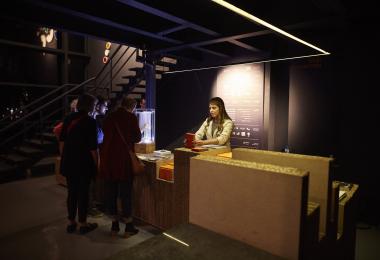
The Hangar Exhibition
Information Desk
© Amman Design Week 2017
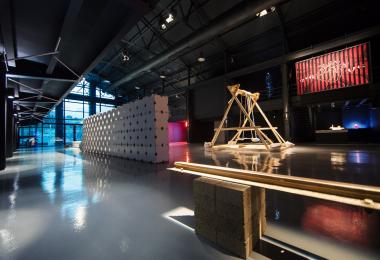
The Hangar Exhibition
Works by Yasmeen Sabri, Haya Abulhameed, and Kais Al-Rawi, Marie Boltenstern, Julia Koerner
© Amman Design Week 2017
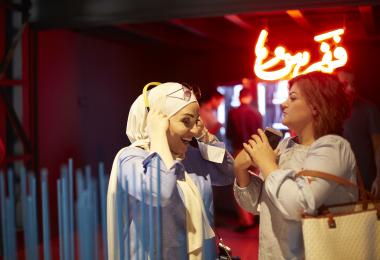
The Hangar Exhibition
© Amman Design Week 2017
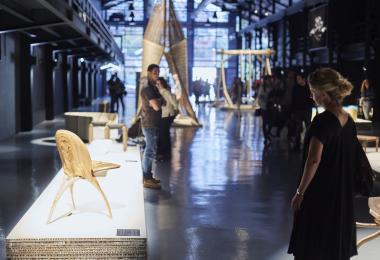
The Hangar Exhibition
Works by Ammar Kalo and other artists/designers.
© Amman Design Week 2017
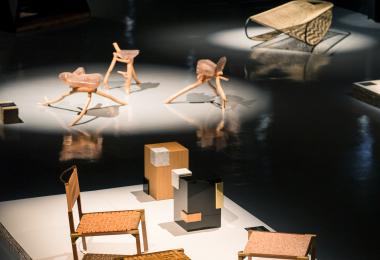
The Hangar Exhibition
Top View: Works by Architecture + Other Things, Jafar Dajani, and Lujain Rezk.
© Amman Design Week 2017
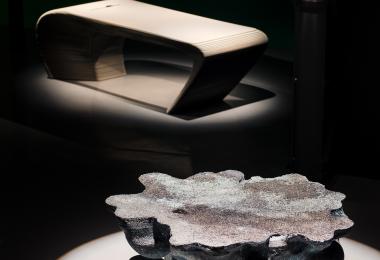
The Hangar Exhibition
Top View: Works by Yasmeen Hamouda and Hanna Salameh
© Amman Design Week 2017
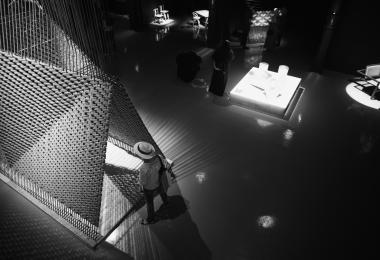
The Hangar Exhibition
Top view: Installation by Anmahian Winton Architects
© Amman Design Week 2017
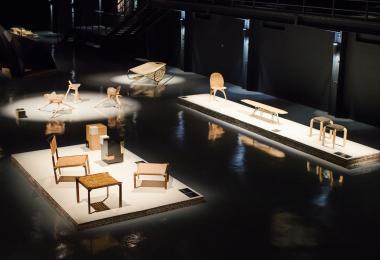
The Hangar Exhibition
Top View: Works by Architecture + Other Things, Jafar Dajani, Lujaine Rizk, and Ammar Kalo.
© Amman Design Week 2017
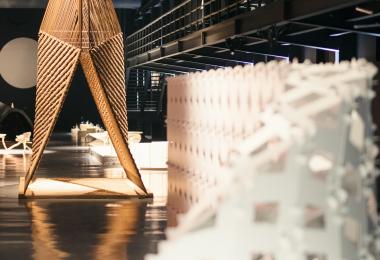
The Hangar Exhibition
Works by Anmahian Winton Architects and Kais Al-Rawi, Marie Boltenstern, Julia Koerner
© Amman Design Week 2017
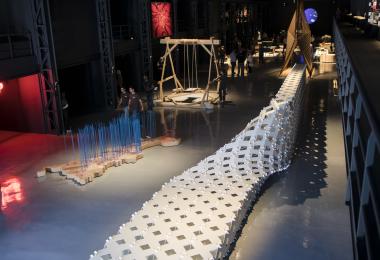
Cellular Complexity (2012)
Kais Al-Rawi, Marie Boltenstern, Julia Koerner
Cellular Complexity is a design research and collaboration between Kais Al-Rawi, Julia Koerner and Marie Boltenstern established in 2012 at the Architectural Association London.
The research investigates complex cellular systems and their potential for architectural applications that utilize efficient space-packing geometries with a special focus on emergent technologies in architecture and design. Cellular systems exist within the organization of biological systems in a multitude of scales from the nano to the micro and macro; they embody performative properties structurally, thermally and acoustically.
The installation rethinks the scale at which these systems organically exist, towards an architectural scale which can be re-organized to a diverse range of applications and performative parameters. This installation received the prestigious American Institute of Architects (AIA) Merit Design Award for Built Project in Los Angeles, California (2015).
© Amman Design Week 2017
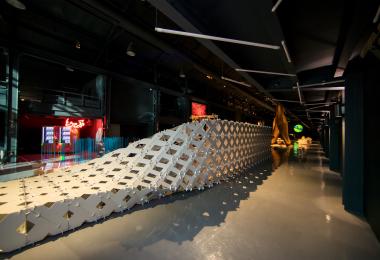
Cellular Complexity (2012)
Kais Al-Rawi, Marie Boltenstern, Julia Koerner
Cellular Complexity is a design research and collaboration between Kais Al-Rawi, Julia Koerner and Marie Boltenstern established in 2012 at the Architectural Association London.
The research investigates complex cellular systems and their potential for architectural applications that utilize efficient space-packing geometries with a special focus on emergent technologies in architecture and design. Cellular systems exist within the organization of biological systems in a multitude of scales from the nano to the micro and macro; they embody performative properties structurally, thermally and acoustically.
The installation rethinks the scale at which these systems organically exist, towards an architectural scale which can be re-organized to a diverse range of applications and performative parameters. This installation received the prestigious American Institute of Architects (AIA) Merit Design Award for Built Project in Los Angeles, California (2015).
© Amman Design Week 2017
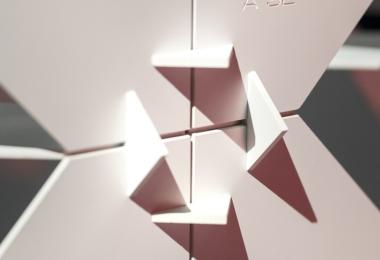
Cellular Complexity (2012)
Kais Al-Rawi, Marie Boltenstern, Julia Koerner
Cellular Complexity is a design research and collaboration between Kais Al-Rawi, Julia Koerner and Marie Boltenstern established in 2012 at the Architectural Association London.
The research investigates complex cellular systems and their potential for architectural applications that utilize efficient space-packing geometries with a special focus on emergent technologies in architecture and design. Cellular systems exist within the organization of biological systems in a multitude of scales from the nano to the micro and macro; they embody performative properties structurally, thermally and acoustically.
The installation rethinks the scale at which these systems organically exist, towards an architectural scale which can be re-organized to a diverse range of applications and performative parameters. This installation received the prestigious American Institute of Architects (AIA) Merit Design Award for Built Project in Los Angeles, California (2015).
© Amman Design Week 2017
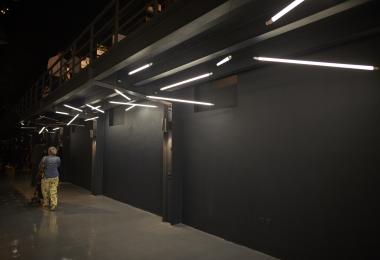
Awning (2017)
Haya Abdul Hameed
'Awning' is traditionally defined as a roof-like shelter providing protection from sun or rain. Artist Haya Abdul Hameed created a lighting installation that takes the essence of shelter and redefines its function in relation to the power of many. It is activated by movement sensors to 'shade' those who walk under it. The more people there are, the more it lights.
© Amman Design Week 2017
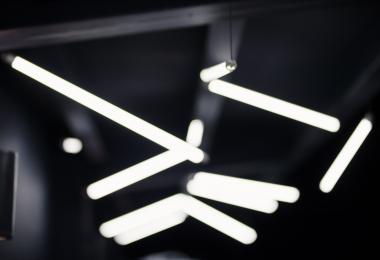
Awning (2017)
Haya Abdul Hameed
'Awning' is traditionally defined as a roof-like shelter providing protection from sun or rain. Artist Haya Abdul Hameed created a lighting installation that takes the essence of shelter and redefines its function in relation to the power of many. It is activated by movement sensors to 'shade' those who walk under it. The more people there are, the more it lights.
© Amman Design Week 2017
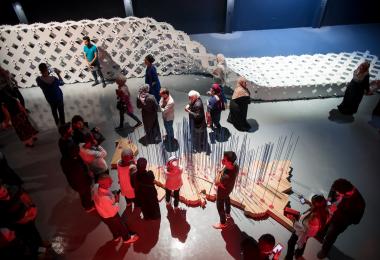
Divided Congregation (2016)
BRICKLAB
'Divided Congregation' uses the lens of the urban landscape to comprehend the shifted role of mosques in the cities surrounding the Gulf; from centers of community gatherings for both sacred and secular purposes to their current function as solely places of worship.
Focusing on the four major quadrants of the city of Jeddah, BRICKLAB performs an audio-visual mapping of mosques in an urban cartographic sculpture. The work attests to the current role of mosques as manifested in the urban fabric of the city, between community centers and mere reflections of their patron’s house in heaven.
© Amman Design Week 2017
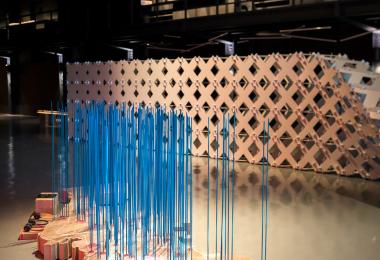
Divided Congregation (2016)
BRICKLAB
'Divided Congregation' uses the lens of the urban landscape to comprehend the shifted role of mosques in the cities surrounding the Gulf; from centers of community gatherings for both sacred and secular purposes to their current function as solely places of worship.
Focusing on the four major quadrants of the city of Jeddah, BRICKLAB performs an audio-visual mapping of mosques in an urban cartographic sculpture. The work attests to the current role of mosques as manifested in the urban fabric of the city, between community centers and mere reflections of their patron’s house in heaven.
© Amman Design Week 2017
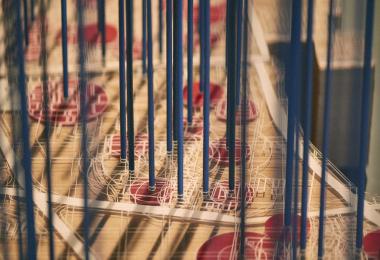
Divided Congregation (2016)
BRICKLAB
'Divided Congregation' uses the lens of the urban landscape to comprehend the shifted role of mosques in the cities surrounding the Gulf; from centers of community gatherings for both sacred and secular purposes to their current function as solely places of worship.
Focusing on the four major quadrants of the city of Jeddah, BRICKLAB performs an audio-visual mapping of mosques in an urban cartographic sculpture. The work attests to the current role of mosques as manifested in the urban fabric of the city, between community centers and mere reflections of their patron’s house in heaven.
© Amman Design Week 2017
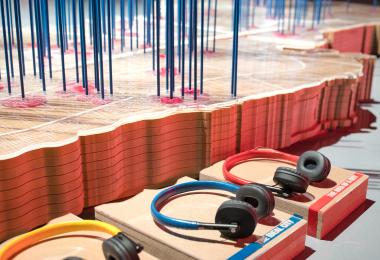
Divided Congregation (2016)
BRICKLAB
'Divided Congregation' uses the lens of the urban landscape to comprehend the shifted role of mosques in the cities surrounding the Gulf; from centers of community gatherings for both sacred and secular purposes to their current function as solely places of worship.
Focusing on the four major quadrants of the city of Jeddah, BRICKLAB performs an audio-visual mapping of mosques in an urban cartographic sculpture. The work attests to the current role of mosques as manifested in the urban fabric of the city, between community centers and mere reflections of their patron’s house in heaven.
© Amman Design Week 2017
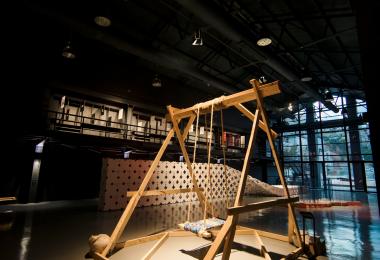
The Network of Swings (2017)
Yasmeen Sabri
‘The Network of Swings’ consists of three swings located at the Hangar, Al-Zaatari camp, and the Ruwwad community center in Jabal al Natheef. The swings were connected via live video stream, allowing people playing on the swings to connect and share the experience. It is a recreation of the traditional 'Eid' swing within the exhibition space, and was accompanied by a D.I.Y. instruction manual for making your own swing.
© Amman Design Week 2017
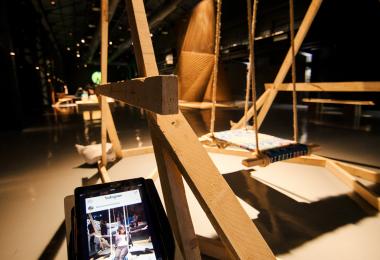
The Network of Swings (2017)
Yasmeen Sabri
‘The Network of Swings’ consists of three swings located at the Hangar, Al-Zaatari camp, and the Ruwwad community center in Jabal al Natheef. The swings were connected via live video stream, allowing people playing on the swings to connect and share the experience. It is a recreation of the traditional 'Eid' swing within the exhibition space, and was accompanied by a D.I.Y. instruction manual for making your own swing.
© Amman Design Week 2017
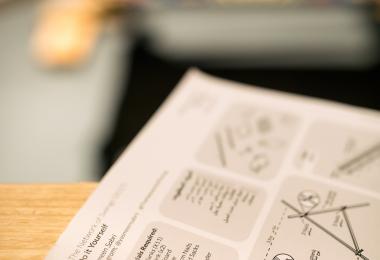
The Network of Swings (2017)
Yasmeen Sabri
‘The Network of Swings’ consists of three swings located at the Hangar, Al-Zaatari camp, and the Ruwwad community center in Jabal al Natheef. The swings were connected via live video stream, allowing people playing on the swings to connect and share the experience. It is a recreation of the traditional 'Eid' swing within the exhibition space, and was accompanied by a D.I.Y. instruction manual for making your own swing.
© Amman Design Week 2017
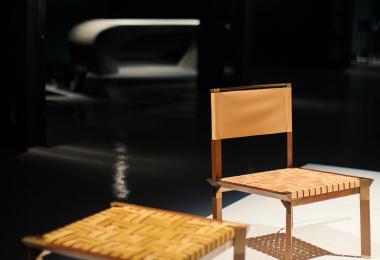
Mirkaz (2017)
Lujaine Rezk
“Mirkaz", is composed of three central pieces: a stool, a small table and chair, all of which are potent symbols of what Lujaine describes as a “rupture between people and places in an urban setting".
© Amman Design Week 2017
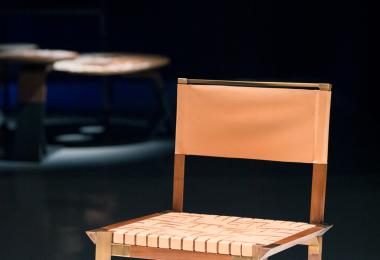
Mirkaz (2017)
Lujaine Rezk
“Mirkaz", is composed of three central pieces: a stool, a small table and chair, all of which are potent symbols of what Lujaine describes as a “rupture between people and places in an urban setting".
© Amman Design Week 2017
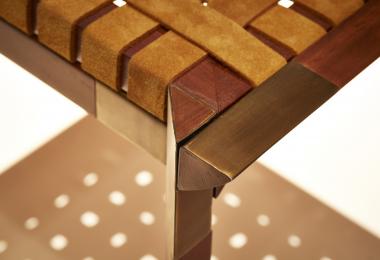
Mirkaz (2017)
Lujaine Rezk
“Mirkaz", is composed of three central pieces: a stool, a small table and chair, all of which are potent symbols of what Lujaine describes as a “rupture between people and places in an urban setting".
© Amman Design Week 2017
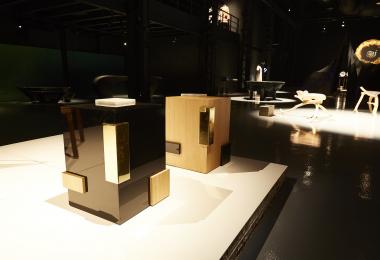
The Occasional Cube Table (2017)
Jafar Dajani
“The Occasional Cube Table,” explores the motion and rotation of squares and rectangles around a three-dimensional object, in a manner reminiscent of the De Stijl movement.
© Amman Design Week 2017
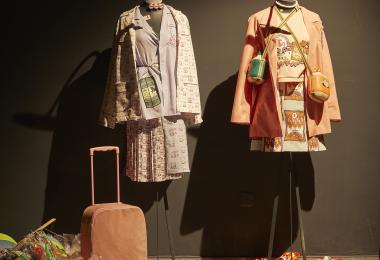
Shibs, Bibs, Canary (2017)
Tania George
The collection explores the youthful joys of the past: the happiness one felt when opening a can of Pepsi, a bag of chips or a bar of Canary wafers.
© Amman Design Week 2017
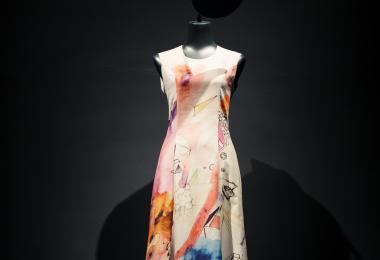
Under the Microscope (2017)
Yasmine Alnabulsi
Yasmine Alnabulsi's characteristic illustrations of seemingly floating whimsical creatures come to life in fabric form at the Hangar Exhibition. These creatures move as if they were lifted from 2D forms into wearable, suspended 3D forms embellished with embroidery and sequins. The work features delicately drawn creatures on a sketchbook or piece of paper which have now become larger, mobile, and animated when worn or suspended.
© Amman Design Week 2017
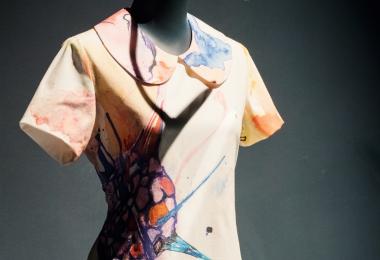
Under the Microscope (2017)
Yasmine Alnabulsi
Yasmine Alnabulsi's characteristic illustrations of seemingly floating whimsical creatures come to life in fabric form at the Hangar Exhibition. These creatures move as if they were lifted from 2D forms into wearable, suspended 3D forms embellished with embroidery and sequins. The work features delicately drawn creatures on a sketchbook or piece of paper which have now become larger, mobile, and animated when worn or suspended.
© Amman Design Week 2017
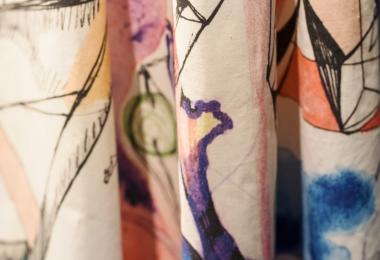
Under the Microscope (2017)
Yasmine Alnabulsi
Yasmine Alnabulsi's characteristic illustrations of seemingly floating whimsical creatures come to life in fabric form at the Hangar Exhibition. These creatures move as if they were lifted from 2D forms into wearable, suspended 3D forms embellished with embroidery and sequins. The work features delicately drawn creatures on a sketchbook or piece of paper which have now become larger, mobile, and animated when worn or suspended.
© Amman Design Week 2017
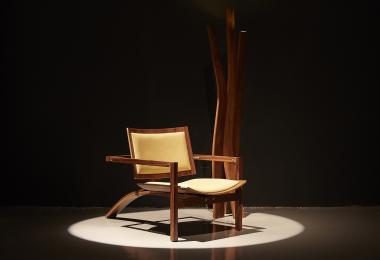
C Chair & Trio Light (2017)
SULi&NAi DESIGN & CRAFT - Suliman Innab, Nabil Innab
This chair and the light were shaped using the steam bending technique which allows the wood's strength or weakness to dictate the resulting form.
The chair structure is made up of three elements; the arch running front to back along the centerline of the chair, supported by the frame which comprises the legs and a cross element, and the back support which is supported on the arch.
A key feature of the chair design is the mechanical connection of the armrest with front legs and the back supports, which adds to the comfort of the chair.
© Amman Design Week 2017
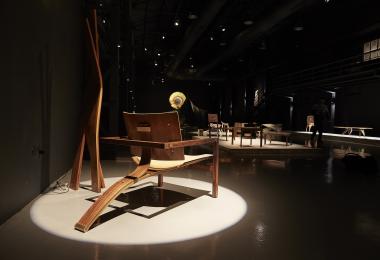
C Chair & Trio Light (2017)
SULi&NAi DESIGN & CRAFT - Suliman Innab, Nabil Innab
This chair and the light were shaped using the steam bending technique which allows the wood's strength or weakness to dictate the resulting form.
The chair structure is made up of three elements; the arch running front to back along the centerline of the chair, supported by the frame which comprises the legs and a cross element, and the back support which is supported on the arch.
A key feature of the chair design is the mechanical connection of the armrest with front legs and the back supports, which adds to the comfort of the chair.
© Amman Design Week 2017
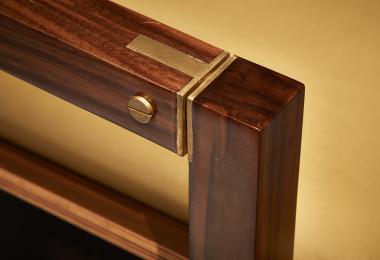
C Chair & Trio Light (2017)
SULi&NAi DESIGN & CRAFT - Suliman Innab, Nabil Innab
This chair and the light were shaped using the steam bending technique which allows the wood's strength or weakness to dictate the resulting form.
The chair structure is made up of three elements; the arch running front to back along the centerline of the chair, supported by the frame which comprises the legs and a cross element, and the back support which is supported on the arch.
A key feature of the chair design is the mechanical connection of the armrest with front legs and the back supports, which adds to the comfort of the chair.
© Amman Design Week 2017
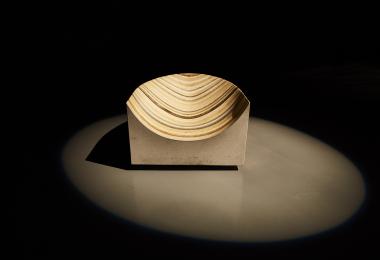
Kutleh (2017)
Rula Yaghmour
‘Kutleh’ (arabic: block) is an attempt to design a new medium, a new 'stone block', from the surplus and waste of the stone industry and construction projects. Inspired by the concrete experiments of Roni Horn's chair, this hyperbolic prototype is carved out of the 'block', and assembled from reclaimed tiles of stone, marble and granite slabs.
© Amman Design Week 2017
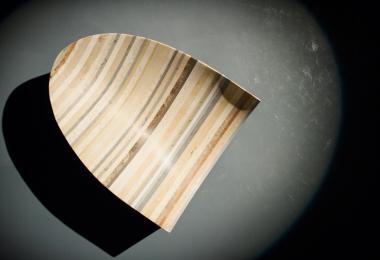
Kutleh (2017)
Rula Yaghmour
‘Kutleh’ (arabic: block) is an attempt to design a new medium, a new 'stone block', from the surplus and waste of the stone industry and construction projects. Inspired by the concrete experiments of Roni Horn's chair, this hyperbolic prototype is carved out of the 'block', and assembled from reclaimed tiles of stone, marble and granite slabs.
© Amman Design Week 2017
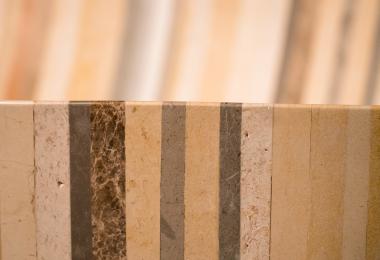
Kutleh (2017)
Rula Yaghmour
‘Kutleh’ (arabic: block) is an attempt to design a new medium, a new 'stone block', from the surplus and waste of the stone industry and construction projects. Inspired by the concrete experiments of Roni Horn's chair, this hyperbolic prototype is carved out of the 'block', and assembled from reclaimed tiles of stone, marble and granite slabs.
© Amman Design Week 2017
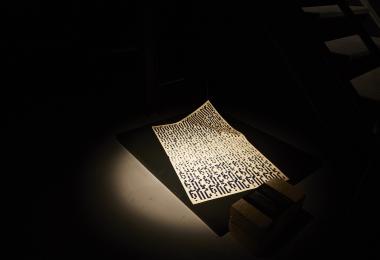
Reinterpreting Ritual Aesthetics (2016)
Rasha Dakkak
‘Reinterpreting Ritual Aesthetics’ represents an ongoing attempt to distinguish between living tradition and hollow convention, a fundamental confusion the region suffers from with regards to the veneration of tradition. In 'Sajjadah 01', a calligraphic image-text is employed inspiring contemplation of its display by shifting across semiotic registers, challenging the resistance against the use of lettering as a motif.
© Amman Design Week 2017
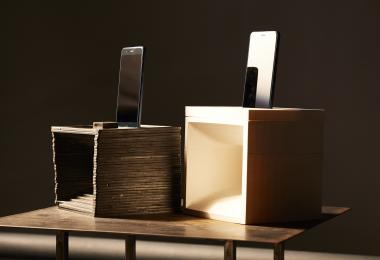
98f (2017)
Katia Al Tal - Nuwa Creations
This sound amplifier is made of laser-cut layers of different materials to form a horn-like structure within the simple cube. Through a manual mechanism that generates a rotational movement, it amplifies a smartphone's sound naturally without the need of an external power source.
© Amman Design Week 2017
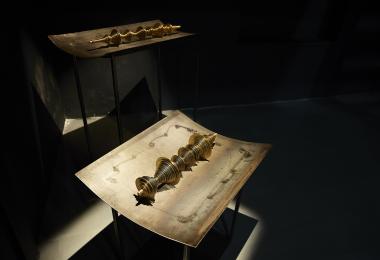
Basmala (2017)
Nedim Kufi
This copper sculpture is the physical embodiment of the sound wave of a human voice reciting the Basmala, which is the opening phrase of the Holy Qur’an meaning “In the name of God, the Most Compassionate, the Most Merciful”. It is an experiment in synesthesia, transforming a sound wave into a physical body.
Beyond the five obligatory prayers, Basmala is recited before beginning work or undertaking a new task, and is even used in rule of law as a preamble to state constitutions. It is a powerful image as well as a sonic symbol. Calligraphic depictions of the Basmala have taken on the power of icons in Islamic art and architecture.
© Amman Design Week 2017
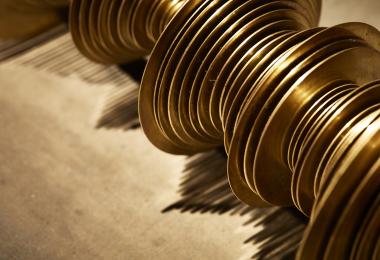
Basmala (2017)
Nedim Kufi
This copper sculpture is the physical embodiment of the sound wave of a human voice reciting the Basmala, which is the opening phrase of the Holy Qur’an meaning “In the name of God, the Most Compassionate, the Most Merciful”. It is an experiment in synesthesia, transforming a sound wave into a physical body.
Beyond the five obligatory prayers, Basmala is recited before beginning work or undertaking a new task, and is even used in rule of law as a preamble to state constitutions. It is a powerful image as well as a sonic symbol. Calligraphic depictions of the Basmala have taken on the power of icons in Islamic art and architecture.
© Amman Design Week 2017
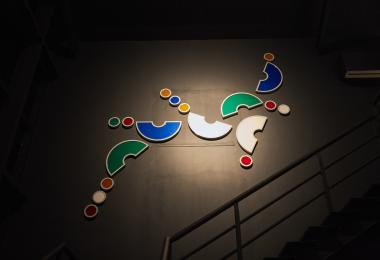
The Dancing Letters Wall Piece / Three Arabic letters: Baa, Taa & Thaa (2017)
Hayan Maani
Hayan designed ‘The Dancing Letters Wall Piece / Three Arabic letters: Baa, Taa & Thaa’, hanging above the stairs in the Hangar Exhibition going up to the Education Zone.
© Amman Design Week 2017
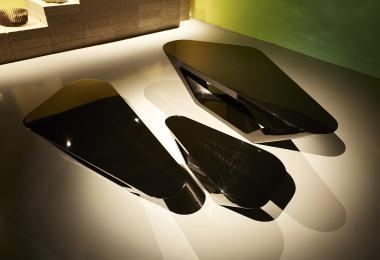
The Alveolar Table (2017)
Naim Y Snobar
The table abstracts dynamic organic forms into simplified geometric shapes for ease of production using mathematical and geometrical methods. The shapes were machine-cut out of steel sheets, then bent, welded, painted, and finished.
© Amman Design Week 2017
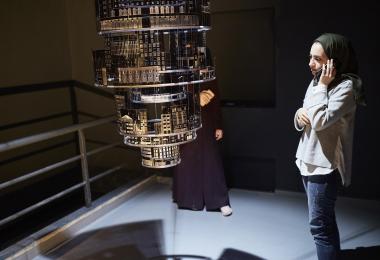
Amman Moving in Eight Circles (2017)
Nadeen Dihmes
This piece celebrates the eight roundabouts of Amman, from First to Eighth, along one of the city’s main spines: Zahran Street. As significant elements of the city’s expansion, movement and growth, the circles are reinterpreted as a destination. The eight circles are collocated around a single center, superimposing their unique skylines and reflecting their true land elevations.
© Amman Design Week 2017
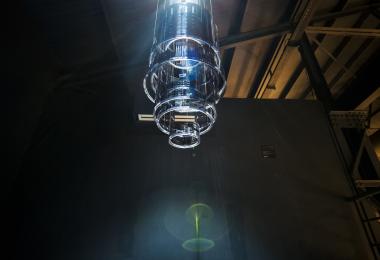
Amman Moving in Eight Circles (2017)
Nadeen Dihmes
This piece celebrates the eight roundabouts of Amman, from First to Eighth, along one of the city’s main spines: Zahran Street. As significant elements of the city’s expansion, movement and growth, the circles are reinterpreted as a destination. The eight circles are collocated around a single center, superimposing their unique skylines and reflecting their true land elevations.
© Amman Design Week 2017
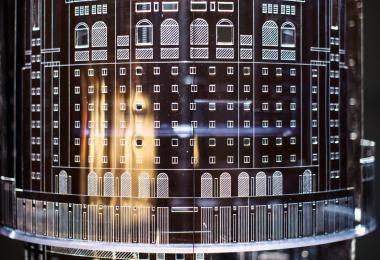
Amman Moving in Eight Circles (2017)
Nadeen Dihmes
This piece celebrates the eight roundabouts of Amman, from First to Eighth, along one of the city’s main spines: Zahran Street. As significant elements of the city’s expansion, movement and growth, the circles are reinterpreted as a destination. The eight circles are collocated around a single center, superimposing their unique skylines and reflecting their true land elevations.
© Amman Design Week 2017
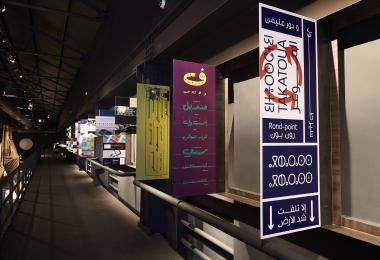
Typography Wall
© Amman Design Week 2017
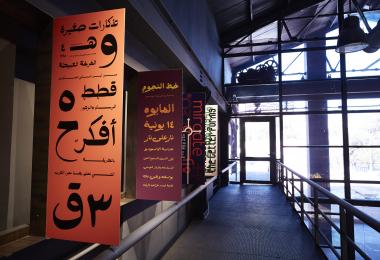
Typography Wall
© Amman Design Week 2017
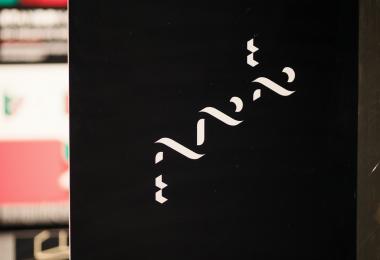
Logo Wall
© Amman Design Week 2017
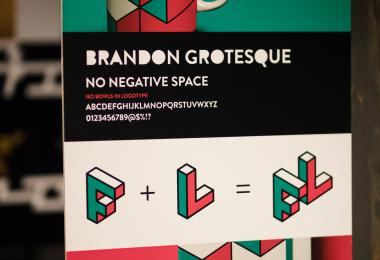
Logo Wall
© Amman Design Week 2017
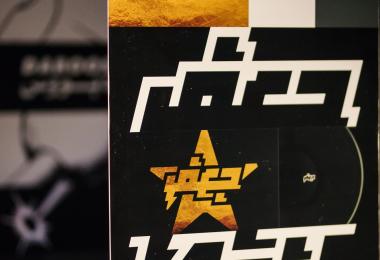
Logo Wall
© Amman Design Week 2017
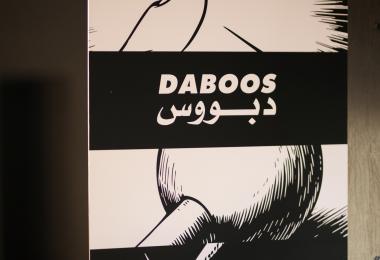
Logo Wall
© Amman Design Week 2017
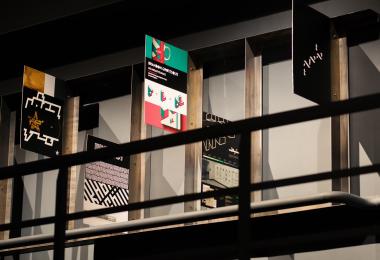
Logo Wall
© Amman Design Week 2017
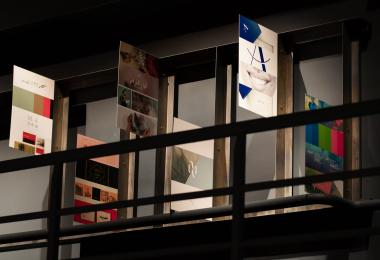
Logo Wall
© Amman Design Week 2017
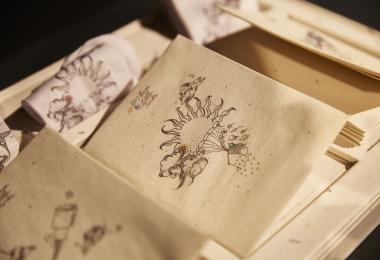
Three Little Socks (2017)
Shorouq Kandeel, Merna Ayman, Asmaa Mostafa
‘Three Little Socks’ is an abstract introductory narration of the past, present and future states of Syria and aims to open a dialog between a parent, who is already aware of the real events, and a child.
© Amman Design Week 2017
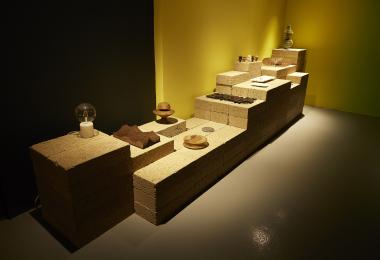
In Doi Collection (2017)
In Doi
This collection joins traditional Jordanian craftsmanship with cutting-edge fabrication processes, reinterpreting local techniques in a modern framework. Each product is derived from a careful study of the traditional and the functional, followed by the conception of a model that defies any preconceptions. The handmade process distinguishes the products from the mass produced.
© Amman Design Week 2017
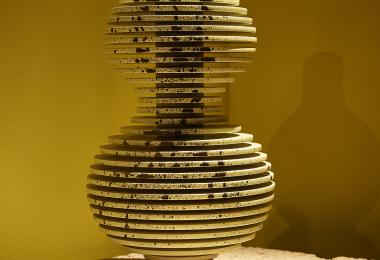
In Doi Collection (2017)
In Doi
This collection joins traditional Jordanian craftsmanship with cutting-edge fabrication processes, reinterpreting local techniques in a modern framework. Each product is derived from a careful study of the traditional and the functional, followed by the conception of a model that defies any preconceptions. The handmade process distinguishes the products from the mass produced.
© Amman Design Week 2017
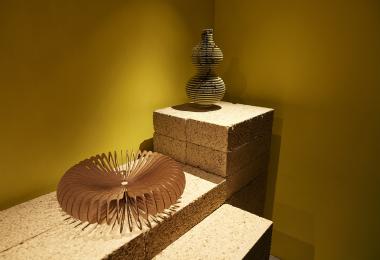
In Doi Collection (2017)
In Doi
This collection joins traditional Jordanian craftsmanship with cutting-edge fabrication processes, reinterpreting local techniques in a modern framework. Each product is derived from a careful study of the traditional and the functional, followed by the conception of a model that defies any preconceptions. The handmade process distinguishes the products from the mass produced.
© Amman Design Week 2017
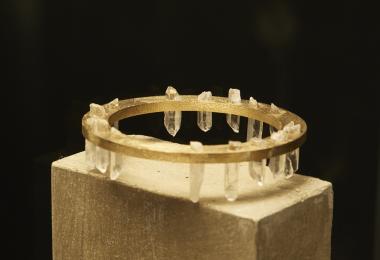
Personification (2017)
Ola Medanat Jewelry
Hand molded silver, gold plated. Stones are crystals including quartz.
© Amman Design Week 2017
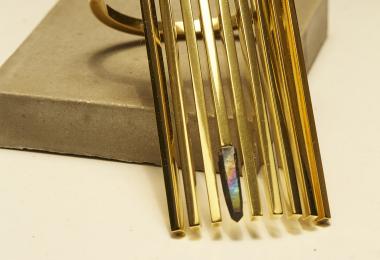
Personification (2017)
Ola Medanat Jewelry
© Amman Design Week 2017
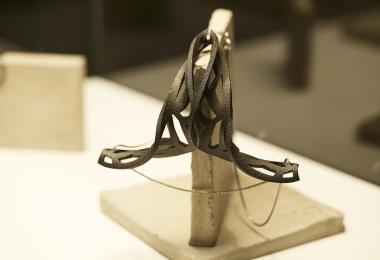
Stray Collection (2017)
Hala Ghatasheh
Using generative design and digital manufacturing, the ‘Stray Collection’ is a product of an experimental study that explores the possibilities of merging architecture, technology and fashion.
© Amman Design Week 2017
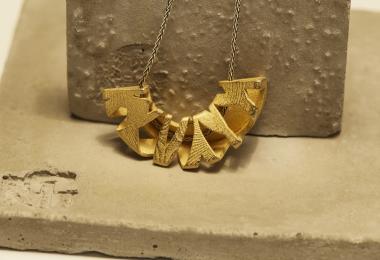
Stray Collection (2017)
Hala Ghatasheh
The pieces are designed to follow the natural body curvature, generating statement pieces that complement the female figure.
© Amman Design Week 2017
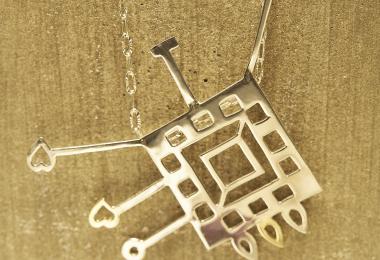
Dana Rousan Contemporary Jewelry Collection (2017)
Dana Rousan
18kt gold with sterling silver.
© Amman Design Week 2017
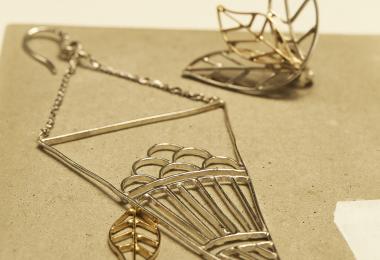
Dana Rousan Contemporary Jewelry Collection (2017)
Dana Rousan
18kt gold with sterling silver.
© Amman Design Week 2017
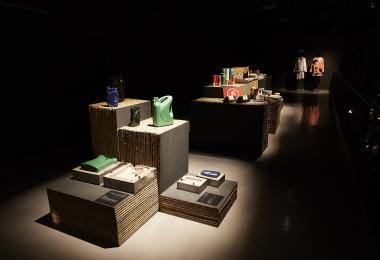
The Hangar Exhibition
Packaging design
© Amman Design Week 2017
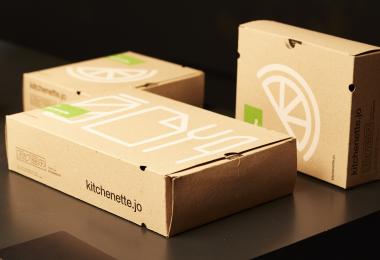
Kitchenette (2015)
Overhaul - Rami Kilani, Hani Ameer, Saed Saleh
© Amman Design Week 2017
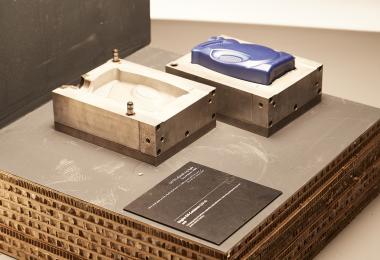
Engine Oil Container (2016)
MKD
Packaging design for JoPetrol, inspired by Arabic letterforms, made using casting techniques and plastic injection molding.
© Amman Design Week 2017
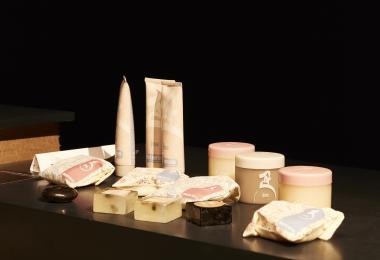
JOA Hand & Body lotion tube
Hussein Alazaat and Mohammad Assaf
© Amman Design Week 2017
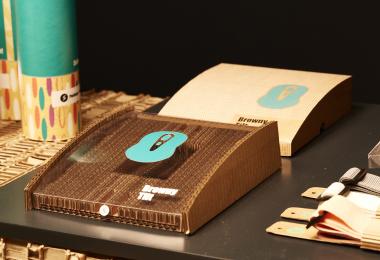
Package becomes Product (2017)
Float Design and Production
This project delves into the world of smart, reusable secondary packaging solutions.
© Amman Design Week 2017
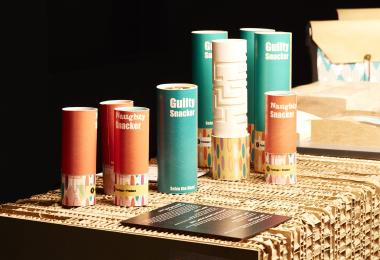
Package becomes Product (2017)
Float Design and Production
By using layered corrugated cardboard, strengthened paper composites and modern textiles, the disposable brown box is evolved into an attractive, functional and durable package that serves to protect the product for the entire post-packaging process; from the factory floor to the end user and then as an independent product with an extended lifecycle.
© Amman Design Week 2017
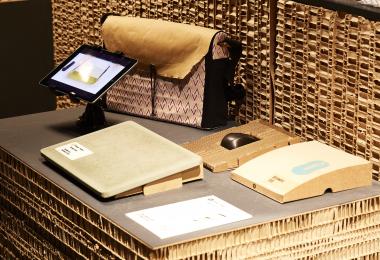
Package becomes Product (2017)
Float Design and Production
© Amman Design Week 2017
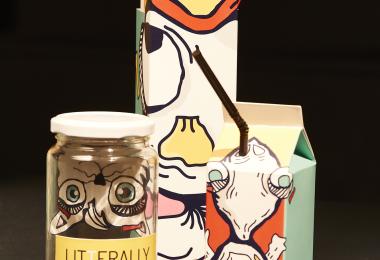
Litterally (2017)
Abeer Anabtawi
‘Litterally’ seeks to raise awareness about the environment and the damage humans have inflicted upon it. The concept is based on a viral video that shows a straw being pulled out of a turtle's nostril.
© Amman Design Week 2017
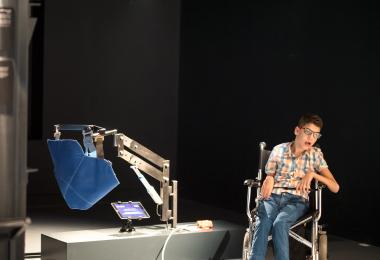
Car Chair Lift (2017)
Hanaa Jubeh
The ‘Car Chair Lift’ is designed for people with physical disabilities. The device allows people to independently transfer themselves from the wheelchair into a car without being carried. The device uses electricity from the car and can be modified to suit any car's dimensions.
© Amman Design Week 2017
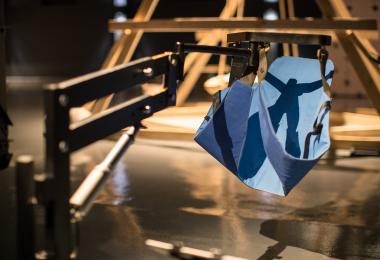
Car Chair Lift (2017)
Hanaa Jubeh
The ‘Car Chair Lift’ is designed for people with physical disabilities. The device allows people to independently transfer themselves from the wheelchair into a car without being carried. The device uses electricity from the car and can be modified to suit any car's dimensions.
© Amman Design Week 2017
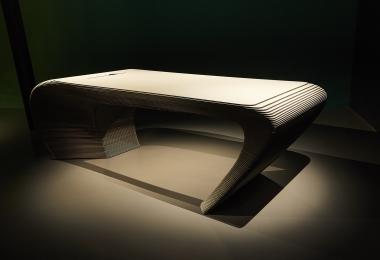
FLO DESK (2017)
Hanna Salameh Design
Inspired by natural shapes of the Wadi Rum desert in Jordan, ‘FLO DESK’ was designed using digital modeling software, merging art and design.
© Amman Design Week 2017
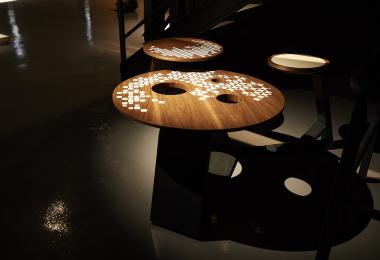
Tabliye' (2017)
Hala Younes
© Amman Design Week 2017
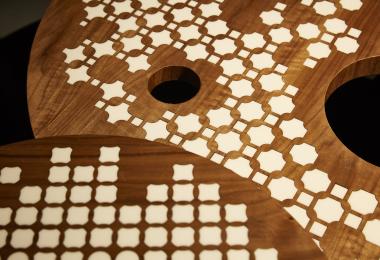
Tabliye' (2017)
Hala Younes
© Amman Design Week 2017
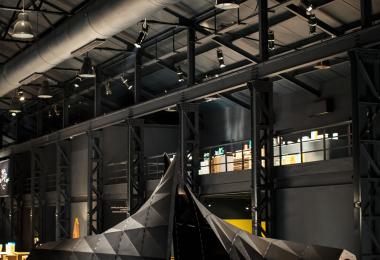
Keswa (2015)
Studio NAS - Salwa Al Khudairi, Nada Al Mulla
'Keswa,' meaning covering, mimics the abaya that some women of the Arab/Islamic world wear.
The steel piece folds in a geometric way that allows the structure to curve and achieve a rhythmic flow, emulating fabric. The outside is smooth and rhythmic just like that of the abaya, while the inside reveals the hidden ribs that hold the structure up and give it its character.
© Amman Design Week 2017
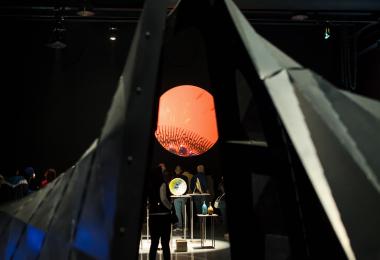
Keswa (2015)
Studio NAS - Salwa Al Khudairi, Nada Al Mulla
'Keswa,' meaning covering, mimics the abaya that some women of the Arab/Islamic world wear.
The steel piece folds in a geometric way that allows the structure to curve and achieve a rhythmic flow, emulating fabric. The outside is smooth and rhythmic just like that of the abaya, while the inside reveals the hidden ribs that hold the structure up and give it its character.
© Amman Design Week 2017
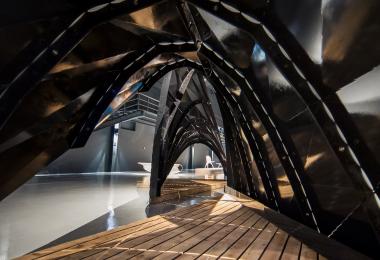
Keswa (2015)
Studio NAS - Salwa Al Khudairi, Nada Al Mulla
'Keswa,' meaning covering, mimics the abaya that some women of the Arab/Islamic world wear.
The steel piece folds in a geometric way that allows the structure to curve and achieve a rhythmic flow, emulating fabric. The outside is smooth and rhythmic just like that of the abaya, while the inside reveals the hidden ribs that hold the structure up and give it its character.
© Amman Design Week 2017
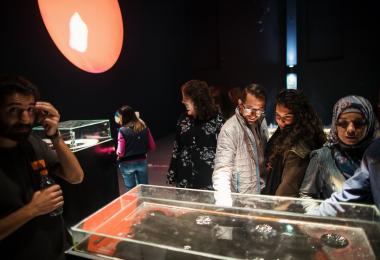
Ferromancy - Animating the Inanimate (2017)
Hashem Joucka
‘Ferromancy’ consists of a set of three interactive installations. Reflecting on the influence of electromagnetic force on our daily existence, its origin and evolution, this project grants life to a material by using an invisible force and making the invisible visible.
© Amman Design Week 2017
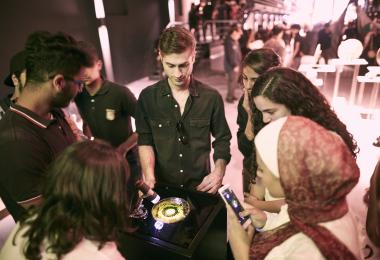
Ferromancy - Animating the Inanimate (2017)
Hashem Joucka
‘Ferromancy’ consists of a set of three interactive installations. Reflecting on the influence of electromagnetic force on our daily existence, its origin and evolution, this project grants life to a material by using an invisible force and making the invisible visible.
© Amman Design Week 2017
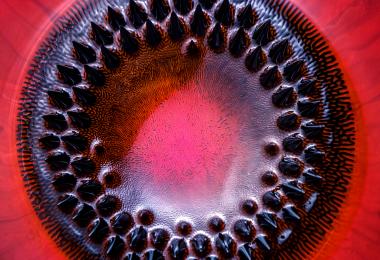
Ferromancy - Animating the Inanimate (2017)
Hashem Joucka
‘Ferromancy’ consists of a set of three interactive installations. Reflecting on the influence of electromagnetic force on our daily existence, its origin and evolution, this project grants life to a material by using an invisible force and making the invisible visible.
© Amman Design Week 2017
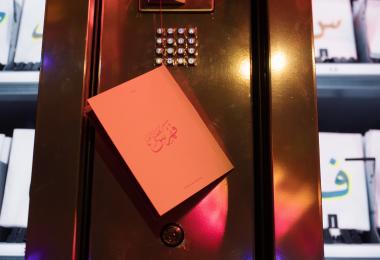
Fahres Al-Khattat (2017)
eyen design
‘Fahres Al-Khattat’ is a cause-driven nonprofit publication and interactive installation that aims to support the calligraphers in Jordan. It is a 'fehras' or guide which features a variety of calligraphy works, attributed to their respective calligraphers and paired with contact details, specialties and services offered. Collectively, the publication positions itself as a portfolio and a living documentation rather than the traditional directory listings. Each publication is enveloped in a yafta (banner) fabric book jacket with hand-written calligraphy of the Arabic alphabet.
The publication was distributed during Amman Design Week via a vending machine.
© Amman Design Week 2017
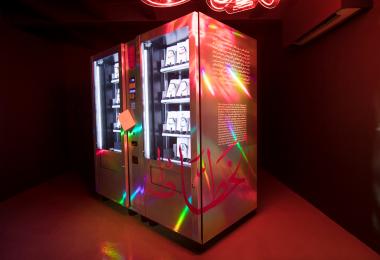
Fahres Al-Khattat (2017)
eyen design
‘Fahres Al-Khattat’ is a cause-driven nonprofit publication and interactive installation that aims to support the calligraphers in Jordan. It is a 'fehras' or guide which features a variety of calligraphy works, attributed to their respective calligraphers and paired with contact details, specialties and services offered. Collectively, the publication positions itself as a portfolio and a living documentation rather than the traditional directory listings. Each publication is enveloped in a yafta (banner) fabric book jacket with hand-written calligraphy of the Arabic alphabet.
The publication was distributed during Amman Design Week via a vending machine.
© Amman Design Week 2017
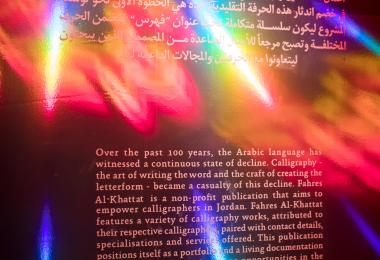
Fahres Al-Khattat (2017)
eyen design
‘Fahres Al-Khattat’ is a cause-driven nonprofit publication and interactive installation that aims to support the calligraphers in Jordan. It is a 'fehras' or guide which features a variety of calligraphy works, attributed to their respective calligraphers and paired with contact details, specialties and services offered. Collectively, the publication positions itself as a portfolio and a living documentation rather than the traditional directory listings. Each publication is enveloped in a yafta (banner) fabric book jacket with hand-written calligraphy of the Arabic alphabet.
The publication was distributed during Amman Design Week via a vending machine.
© Amman Design Week 2017
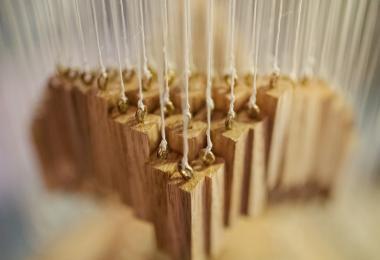
Dynamica (2017)
Dynamica for Kinetic Arts - Akrum Homoud, Anas Omari, Tasneem Jaber
This kinetic suspended wooden ceiling consists of small hanging wooden pieces that are motioned with a simple electromechanical motion system, shaping a three-dimensional wave.
© Amman Design Week 2017
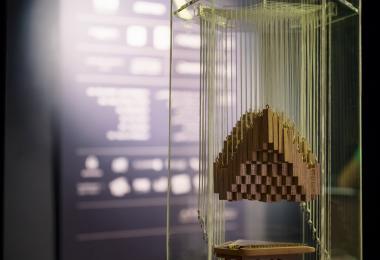
Dynamica (2017)
Dynamica for Kinetic Arts - Akrum Homoud, Anas Omari, Tasneem Jaber
This kinetic suspended wooden ceiling consists of small hanging wooden pieces that are motioned with a simple electromechanical motion system, shaping a three-dimensional wave.
© Amman Design Week 2017
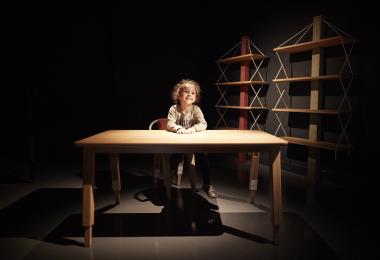
Gym table (2017)
Karmeh Design Studio
The collection of children’s furniture items is inspired by the gymnastics pommel horse.
The chair and table are made of solid wood, metal, and leather, and have height adjustable legs. The floating shelves combine pine and natural rope to create a playful yet practical design.
© Amman Design Week 2017
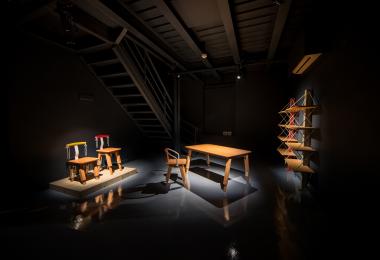
Gym table (2017)
Karmeh Design Studio
The collection of children’s furniture items is inspired by the gymnastics pommel horse.
The chair and table are made of solid wood, metal, and leather, and have height adjustable legs. The floating shelves combine pine and natural rope to create a playful yet practical design.
© Amman Design Week 2017
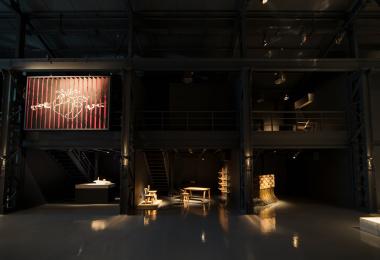
Full Heart (2017)
Dina Fawakhiri
‘Full Heart’ is a still billboard that shows how we would like our heart to appear to others. The installation is a response to the culture of the ‘likes’, hearts, and range of emojis that have evolved into a valid currency in the digital age. Only when the viewer decides to move does it reveal the truth behind what really fills our hearts these days, and the reality of our reaction to the world around us.
© Amman Design Week 2017
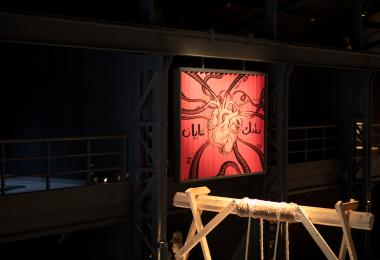
Full Heart (2017)
Dina Fawakhiri
‘Full Heart’ is a still billboard that shows how we would like our heart to appear to others. The installation is a response to the culture of the ‘likes’, hearts, and range of emojis that have evolved into a valid currency in the digital age. Only when the viewer decides to move does it reveal the truth behind what really fills our hearts these days, and the reality of our reaction to the world around us.
© Amman Design Week 2017
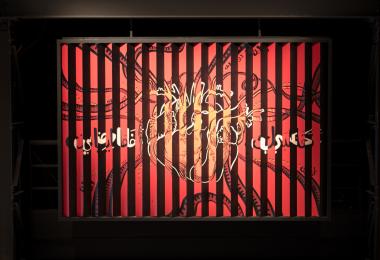
Full Heart (2017)
Dina Fawakhiri
‘Full Heart’ is a still billboard that shows how we would like our heart to appear to others. The installation is a response to the culture of the ‘likes’, hearts, and range of emojis that have evolved into a valid currency in the digital age. Only when the viewer decides to move does it reveal the truth behind what really fills our hearts these days, and the reality of our reaction to the world around us.
© Amman Design Week 2017
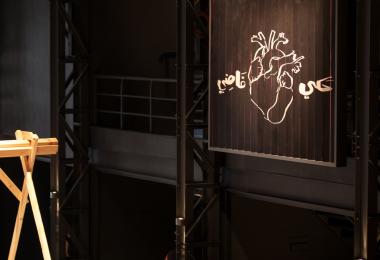
Full Heart (2017)
Dina Fawakhiri
‘Full Heart’ is a still billboard that shows how we would like our heart to appear to others. The installation is a response to the culture of the ‘likes’, hearts, and range of emojis that have evolved into a valid currency in the digital age. Only when the viewer decides to move does it reveal the truth behind what really fills our hearts these days, and the reality of our reaction to the world around us.
© Amman Design Week 2017
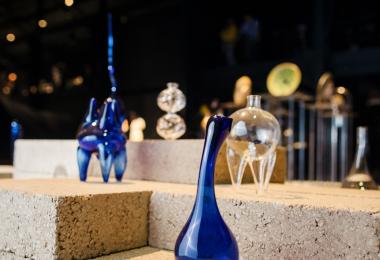
Hollow Forms (Blown Glass) (2017)
Dima Srouji
Hollow Forms is a collection of glass blown objects that were blown in Jaba’, Palestine. The project attempts to reactivate the glass blowing industry and revive traditional craft while learning the ancient techniques that used to draw inspiration from them.
Dima uses digital design and images to communicate the designs to the glassblowers. The aim, with crossing these boundaries, looking back to move forward, is to produce objects that will resonate a sense of place while maintaining the ability to act on a regional and global level. Objects are not blank, hollow shells; rather they have a power to draw people in and alter perceptions.
This is not a sentimental or nostalgic project; this is an attempt to reactivate the industry and revive traditional craft while learning the ancient techniques that are used to draw inspiration from them.
© Amman Design Week 2017
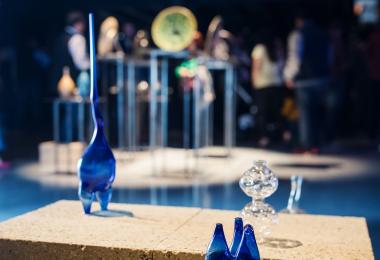
Hollow Forms (Blown Glass) (2017)
Dima Srouji
Hollow Forms is a collection of glass blown objects that were blown in Jaba’, Palestine. The project attempts to reactivate the glass blowing industry and revive traditional craft while learning the ancient techniques that used to draw inspiration from them.
Dima uses digital design and images to communicate the designs to the glassblowers. The aim, with crossing these boundaries, looking back to move forward, is to produce objects that will resonate a sense of place while maintaining the ability to act on a regional and global level. Objects are not blank, hollow shells; rather they have a power to draw people in and alter perceptions.
This is not a sentimental or nostalgic project; this is an attempt to reactivate the industry and revive traditional craft while learning the ancient techniques that are used to draw inspiration from them.
© Amman Design Week 2017
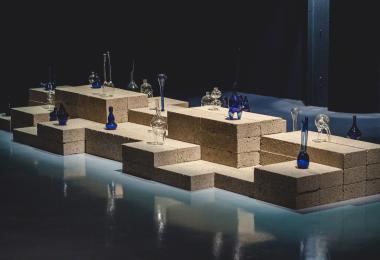
Hollow Forms (Blown Glass) (2017)
Dima Srouji
Hollow Forms is a collection of glass blown objects that were blown in Jaba’, Palestine. The project attempts to reactivate the glass blowing industry and revive traditional craft while learning the ancient techniques that used to draw inspiration from them.
Dima uses digital design and images to communicate the designs to the glassblowers. The aim, with crossing these boundaries, looking back to move forward, is to produce objects that will resonate a sense of place while maintaining the ability to act on a regional and global level. Objects are not blank, hollow shells; rather they have a power to draw people in and alter perceptions.
This is not a sentimental or nostalgic project; this is an attempt to reactivate the industry and revive traditional craft while learning the ancient techniques that are used to draw inspiration from them.
© Amman Design Week 2017
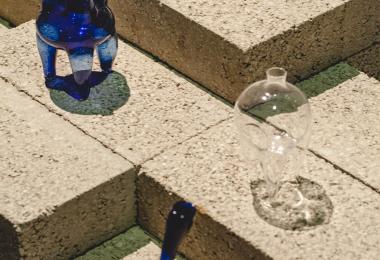
Hollow Forms (Blown Glass) (2017)
Dima Srouji
Hollow Forms is a collection of glass blown objects that were blown in Jaba’, Palestine. The project attempts to reactivate the glass blowing industry and revive traditional craft while learning the ancient techniques that used to draw inspiration from them.
Dima uses digital design and images to communicate the designs to the glassblowers. The aim, with crossing these boundaries, looking back to move forward, is to produce objects that will resonate a sense of place while maintaining the ability to act on a regional and global level. Objects are not blank, hollow shells; rather they have a power to draw people in and alter perceptions.
This is not a sentimental or nostalgic project; this is an attempt to reactivate the industry and revive traditional craft while learning the ancient techniques that are used to draw inspiration from them.
© Amman Design Week 2017
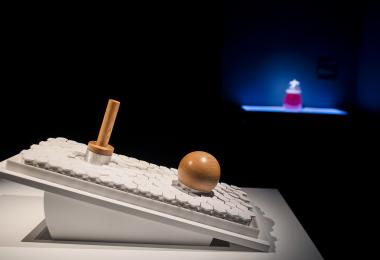
Pushpin Dynamic Surface (2017)
Sahar Madanat Design Studio
This dynamic surface is composed of a grid of dynamic pins that compress down, simply by pressure when something is placed on them. The surrounding uncompressed pins act as walls and provide stability to the item, holding it securely in place to resist shaking and tilting. The compressed pins simply pop right back up once the object is removed, making the surface usable for a variety of different applications.
© Amman Design Week 2017
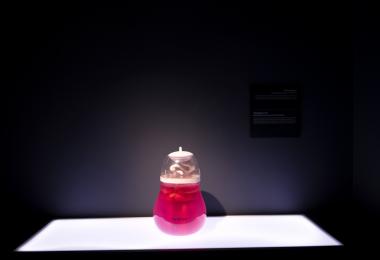
The Brinery (2016)
Bassam Huneidi, Ahreum Jung, Marie Tricaud, Pratik Ghosh
‘The Brinery’ is an at-home vessel that makes the fermentation process much simpler and more attractive to contemporary consumers.
© Amman Design Week 2017
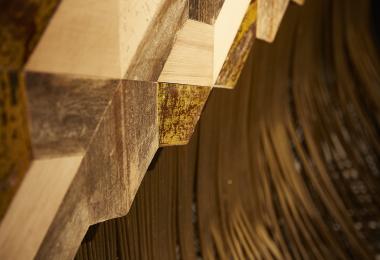
432 Hz Furniture Collection (2017)
Basel Naouri
This furniture collection is made from reclaimed wood and steel. The materials were purposefully left in their original rugged condition to maintain the integrity of their character and highlight the process they underwent before reaching their final polished state.
© Amman Design Week 2017
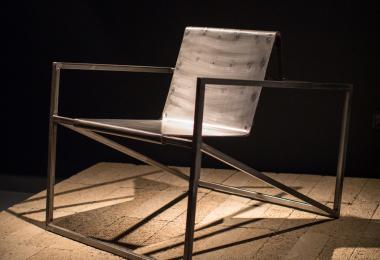
432 Hz Furniture Collection (2017)
Basel Naouri
Inspired by Marcel Breuer's Wassily, this minimal chair highlights the versatility and flexibility of steel in furniture design.
© Amman Design Week 2017
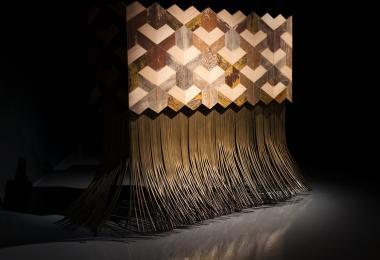
432 Hz Furniture Collection (2017)
Basel Naouri
This furniture collection is made from reclaimed wood and steel. The materials were purposefully left in their original rugged condition to maintain the integrity of their character and highlight the process they underwent before reaching their final polished state. Influenced by the waves of an equalizer in music, these wooden fingers fold in to create a desk with a smooth surface.
© Amman Design Week 2017
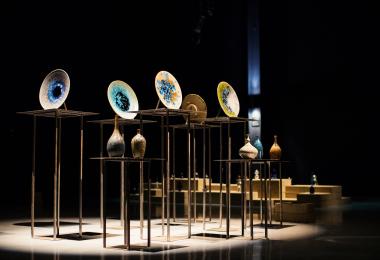
Crystalline Pottery (2017)
Aymen Azzam
Crystalline pottery formed at 1,300 degrees centigrade. The process of making it involves the development of a chemical formula, temperature curve control, and an understanding of the clay used. The work combines science, art and persistence to master the process of crystal growth.
© Amman Design Week 2017
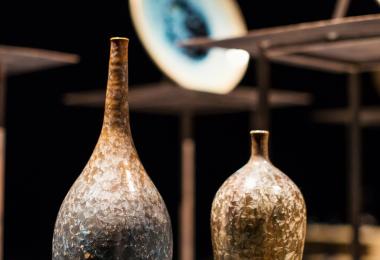
Crystalline Pottery (2017)
Aymen Azzam
Crystalline pottery formed at 1,300 degrees centigrade. The process of making it involves the development of a chemical formula, temperature curve control, and an understanding of the clay used. The work combines science, art and persistence to master the process of crystal growth.
© Amman Design Week 2017
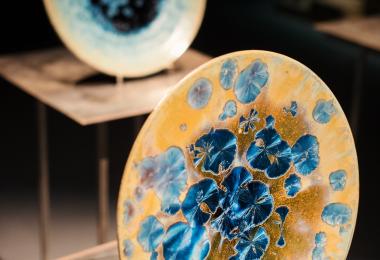
Crystalline Pottery (2017)
Aymen Azzam
Crystalline pottery formed at 1,300 degrees centigrade. The process of making it involves the development of a chemical formula, temperature curve control, and an understanding of the clay used. The work combines science, art and persistence to master the process of crystal growth.
© Amman Design Week 2017
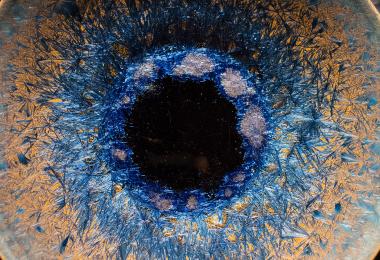
Crystalline Pottery (2017)
Aymen Azzam
Crystalline pottery formed at 1,300 degrees centigrade. The process of making it involves the development of a chemical formula, temperature curve control, and an understanding of the clay used. The work combines science, art and persistence to master the process of crystal growth.
© Amman Design Week 2017
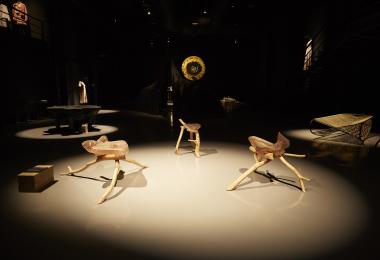
Painterly Structures (2017)
Architecture + Other Things + Ibrahim Ibrahim
Fallen timber members are integrated into a digital and analogue making process that creates functional objects and structures. The work presents an alternative mode of sustainable design practices through the use of found organic material.
© Amman Design Week 2017
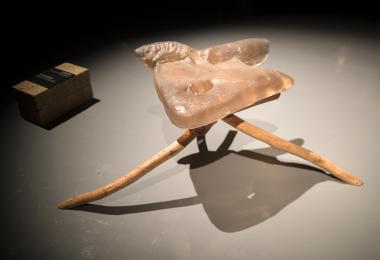
Painterly Structures (2017)
Architecture + Other Things + Ibrahim Ibrahim
Fallen timber members are integrated into a digital and analogue making process that creates functional objects and structures. The work presents an alternative mode of sustainable design practices through the use of found organic material.
© Amman Design Week 2017
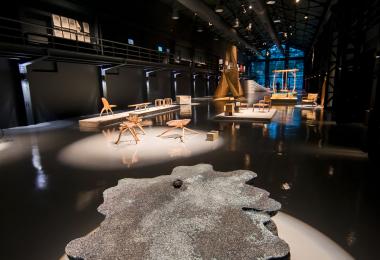
Painterly Structures (2017)
Architecture + Other Things + Ibrahim Ibrahim
© Amman Design Week 2017
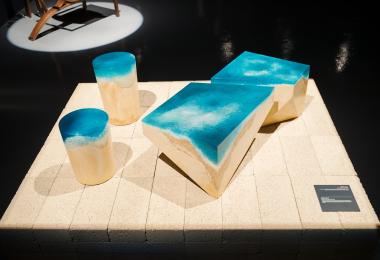
Mirage (2017)
Aperçu - Farah Kayyal and Tarek Hreish
This collection of furniture pieces blends traditional techniques of ‘rammed earth’, which have been brushed aside, and topped with resin.
© Amman Design Week 2017
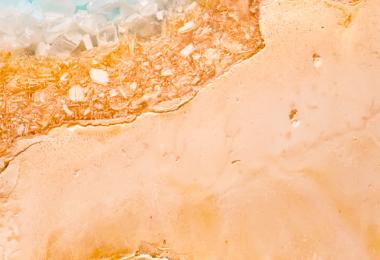
Mirage (2017)
Aperçu - Farah Kayyal and Tarek Hreish
This collection of furniture pieces blends traditional techniques of ‘rammed earth’, which have been brushed aside, with unconventional materials.
© Amman Design Week 2017
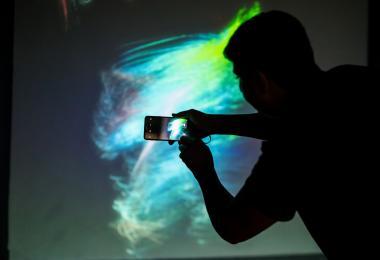
FLUX (2017)
Andrei Visuals
‘FLUX’ leverages state-of-the-art technology with physical expression and visual representation. The outcome is a momentary real-time portrait of an individual, presented digitally and powered by his/her movement.
© Amman Design Week 2017
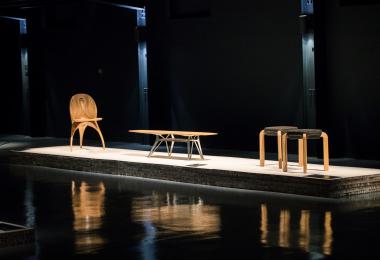
Stratum Chair, TV Stand, and Macaron Seats
Ammar Kalo
© Amman Design Week 2017
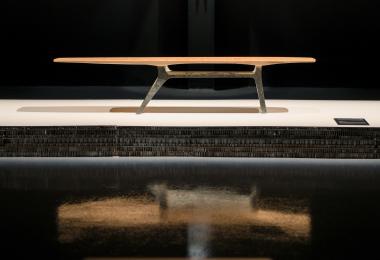
TV Stand (2015)
Ammar Kalo
‘TV Stand’ is an experimental console to hold a TV set and a receiver. Its asymmetrical composition and projecting surfaces create a sense of dynamic balance. The top surface is made from laminated birch plywood that is then milled to the thinnest profile possible which can still support the weight of the television. Etched on its top surface is a stress diagram generated through a digital simulation to show how the console's asymmetry
affects its balance. Its legs and receiver shelf are made of a laser-cut sheet of galvanized steel and folded to create a rigid supporting frame.
© Amman Design Week 2017
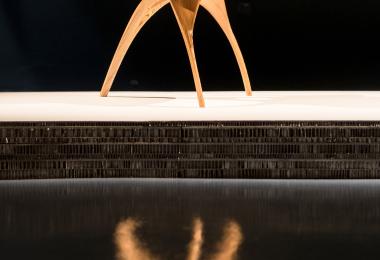
Stratum (2014)
Ammar Kalo
The Stratum chair was born out of a desire to create a chair that expresses its materiality in a very organic fashion, while taking advantage of advanced CNC milling and fabrication technologies. Comprising of two interlocking parts, the chair can fold and reduce its overall volume by half. Sharp sinuous lines run along the edges and highlight the its functional features. The flowing striated pattern is revealed by carving strategically designed local and global geometries into laminated plywood.
© Amman Design Week 2017
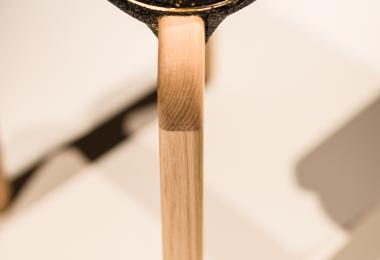
Macaron Seats (2017)
Ammar Kalo
‘Macaron Seats’ explore the softness of recycled rubber crumbs, and their compressibility and ability to bond with other recycled materials such as wood chips in order to redefine the relationship between soft and hard surfaces within a chair. Each ‘Macaron Seat’ is made by pressing a two-part mold onto a pre-made wood frame.
Their main visual characteristics are the chamfered smooth surfaces, rounded off edges, and their distinct fuzzy centerline. Also, mixed in with the rubber crumbs are wood shavings created from the wooden legs fabrication process, giving the rubber seats a contrasting speckled organic look.
© Amman Design Week 2017
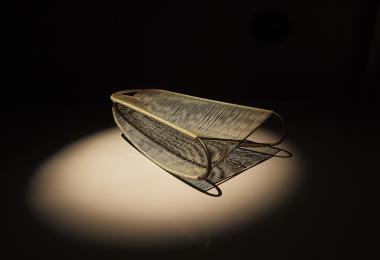
The Rocking Hammock (2017)
Aisha Hamdan
Emerging out of an exploration of floating and feeling weightless, the structure of the Rocking Hammock uses three points instead of the two commonly used by a hammock. The hammock has a minimal structure that keeps the head of the chair cantilevered, while using rope as a material for the body of the chair to soften the harshness of the steel frame.
© Amman Design Week 2017
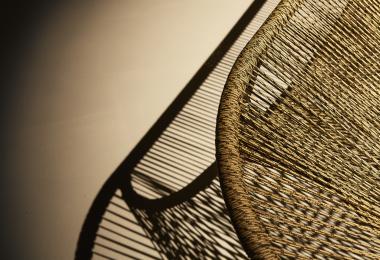
The Rocking Hammock (2017)
Aisha Hamdan
Emerging out of an exploration of floating and feeling weightless, the structure of the Rocking Hammock uses three points instead of the two commonly used by a hammock. The hammock has a minimal structure that keeps the head of the chair cantilevered, while using rope as a material for the body of the chair to soften the harshness of the steel frame.
© Amman Design Week 2017
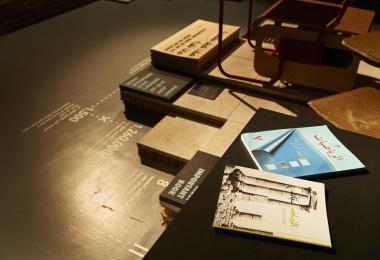
The Most Important Books in Jordan (2015)
Abdulaziz Dhabban
This project is a prototype for the 7th grade official Jordanian mathematics curricula. It tackles visual design as a communication medium and as an educational element.
It's part of a series of "The Most Important" re-designed items for public schools in Jordan.
© Amman Design Week 2017
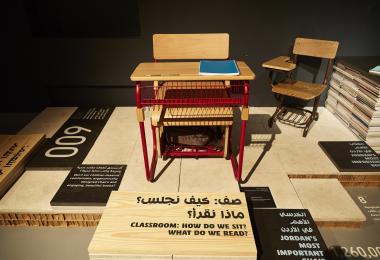
Jordan’s Most Important Chair (2017)
Karmeh Design Studio
The school desk is a study to redesign the public school desk, taking into consideration the materials and manufacturing processes and techniques typically used in producing school desks for public schools in Jordan.
It's part of a series of "The Most Important" re-designed items for public schools in Jordan.
© Amman Design Week 2017
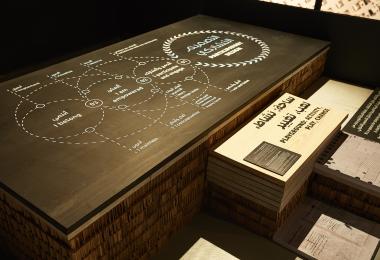
Education Zone
A series of "The Most Important" re-designed items for public schools in Jordan.
© Amman Design Week 2017
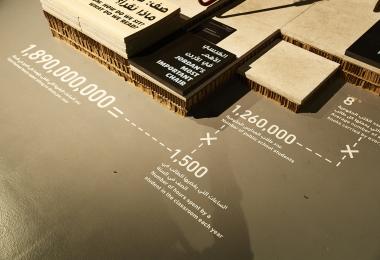
Education Zone
A series of "The Most Important" re-designed items for public schools in Jordan.
© Amman Design Week 2017
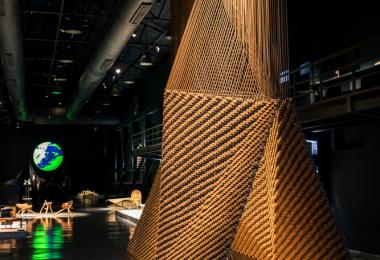
Left of Passage, Right of Passage (2017)
Anmahian Winton Architects
This installation explores the idea of movement through the lens of this complex historical and geological site. By looking into the rawness in both material and idiom, of sandstone and granite striations found in the geology of the valley, the embrace/grasp that the natural space imparts on its travelers to create an inhabitable form is explored.
© Amman Design Week 2017
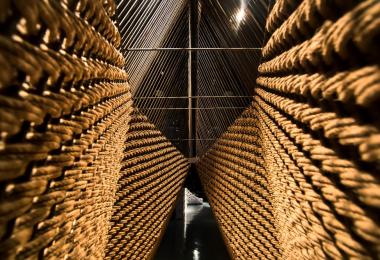
Left of Passage, Right of Passage (2017)
Anmahian Winton Architects
This installation explores the idea of movement through the lens of this complex historical and geological site. By looking into the rawness in both material and idiom, of sandstone and granite striations found in the geology of the valley, the embrace/grasp that the natural space imparts on its travelers to create an inhabitable form is explored.
© Amman Design Week 2017
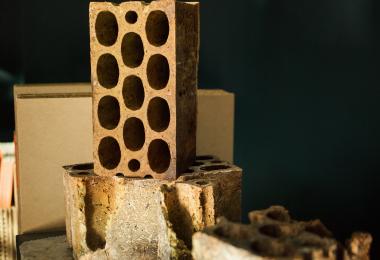
Concrete cake, 2017
Ammar Khammash
© Amman Design Week 2017
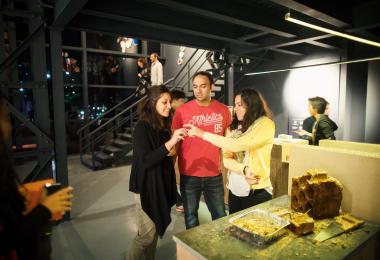
Concrete cake, 2017
Ammar Khammash
© Amman Design Week 2017
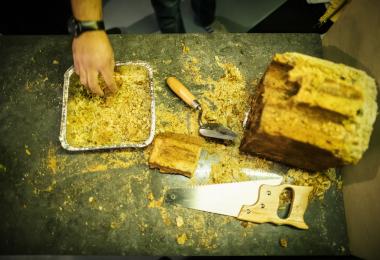
Concrete cake, 2017
Ammar Khammash
© Amman Design Week 2017
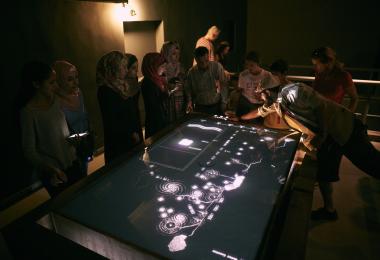
The Water Table (2017)
Ahmad Sabbagh, Michael Schinköthe, Ala’a Ali, Eyas Tayyem, Basheer Anani
'The Water Table' is an interactive installation that uses historical data and future projections to take its users on a journey through time. It brings the profundity of the predicament of Jordan’s water resources to the forefront of the user’s imagination and intends to provoke their desire to act.
© Amman Design Week 2017
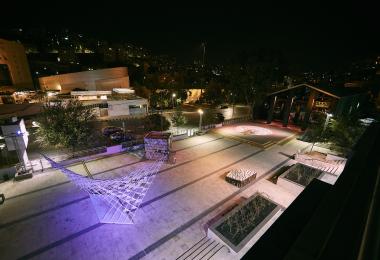
The Hangar Exhibition
© Amman Design Week 2017

